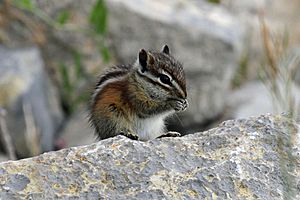Gray-collared chipmunk facts for kids
Quick facts for kids Gray-collared chipmunk |
|
|---|---|
 |
|
| Conservation status | |
| Scientific classification | |
| Genus: |
Neotamias
|
| Species: |
cinereicollis
|
| Synonyms | |
|
Tamias cinereicollis J. A. Allen, 1890 |
|
The gray-collared chipmunk (Neotamias cinereicollis) is a small, quick rodent. It belongs to the squirrel family, called Sciuridae. This chipmunk lives only in certain parts of Arizona and New Mexico in the United States. It's known for the gray fur around its neck.
Contents
Discover the Gray-Collared Chipmunk
What Does It Look Like?
The gray-collared chipmunk is about 225 mm (9 in) long from nose to tail. Its tail makes up a big part of that length, around 98 mm (4 in).
Its forehead is a grayish-brown color. On the sides of its head, it has three dark stripes. The middle stripe goes right through its eye. These dark stripes are separated by bright white bands.
The chipmunk's cheeks, neck, shoulders, and upper back are gray. The rest of its top fur is yellowish-brown. It has five black or dark brown stripes along its back and sides. Sometimes, the outer stripes are hard to see.
Its belly is a pale yellowish-brown. The tail is black on top and creamy-white underneath. Both sides of the tail have a buff (light yellowish-brown) tint. Its feet are a pinkish-buff color. The gray face and collar help tell this chipmunk apart from other chipmunk types.
Where Do Gray-Collared Chipmunks Live?
Mountain Homes in the Southwest
The gray-collared chipmunk lives in mountain forests. These forests are found in central and eastern Arizona. They also live in central and western New Mexico.
You can find them in places like the Bill Williams Mountains and San Francisco Peaks. They also live in the White Mountains in Arizona. In New Mexico, they are in the Datil Mountains and Magdalena Mountains.
High-Altitude Habitats
These chipmunks prefer high places. They live from about 1,950 metres (6,400 ft) up to 3,440 metres (11,290 ft) high. Most often, you'll find them between 2,100 metres (6,900 ft) and 3,300 metres (10,800 ft).
They live in forests with ponderosa pine trees. They also like spruce-fir forests, often near the timberline. This is where trees stop growing due to cold and wind. They are most common where pine and Douglas fir trees grow together. You might also see them in forests with oak and juniper trees.
How Do Gray-Collared Chipmunks Behave?
Daily Activities and Sounds
The gray-collared chipmunk is a great climber. It spends time both in trees and on the ground. You can find them in open areas, at the edge of forests, and deep inside thick woods.
They are quite shy animals. If they get scared, they quickly hide. But when they feel safe, they often sit on a tree stump or a fallen log. They gently wave their tail and make a "chuck-chuck-chuck" sound. If there's danger, their alarm call is a fast, high-pitched "chipper."
What Do They Eat?
These chipmunks mainly eat acorns, fir cones, and berries. They also enjoy seeds from different plants. Sometimes, they eat roots, mushrooms, and green plants. They even eat insects sometimes!
They are very good at storing food. They hide food in holes and cracks. This stored food helps them later, especially when food is scarce.
Life Cycle and Reproduction
Raising Young Chipmunks
Gray-collared chipmunks usually have their babies in late spring and early summer. They build their nests in hidden spots. These can be under a log or rock, among tree roots, or inside a tree hole.
The nest is shaped like a ball. It's made cozy with grass stems and weeds. After about 30 days, the mother gives birth to a litter of around five young chipmunks. The babies drink their mother's milk for about 40 days or longer.
Winter Habits
Sometimes, gray-collared chipmunks will hibernate in winter. This means they go into a deep sleep to save energy. But other times, they stay active, even when it's snowy! If the weather is really bad, they might stay in their nest. They use the food they stored to get through these tough times.
Conservation Status
Are They Safe?
The IUCN lists the gray-collared chipmunk as "least concern." This is good news! It means they are not currently in danger of disappearing.
They are common in the areas where they live. There are no big threats to them right now. Their numbers seem to be staying steady. In some parts of Arizona, scientists found about five chipmunks per hectare in April. This number grew to about twelve per hectare by August.
See also
 In Spanish: Ardilla de pata anillada para niños
In Spanish: Ardilla de pata anillada para niños


